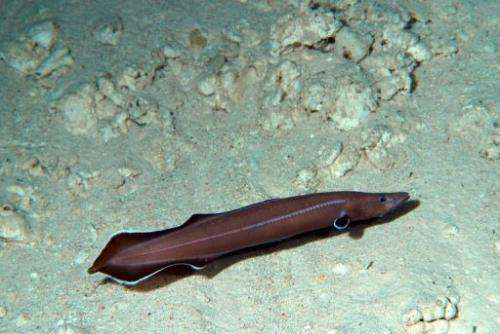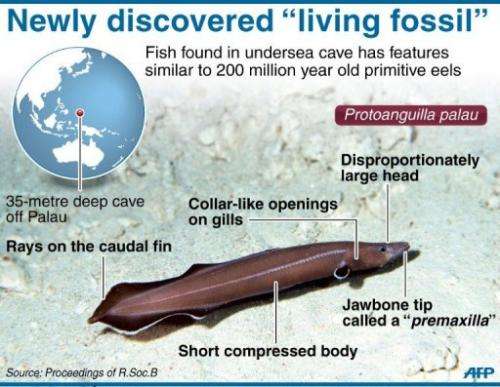An handout picture release by the Natural History Museum & Institute of Chiba shows a new species of eel found in the gloom of an undersea cave which is a "living fossil" astonishingly similar to the first eels that swam some 200 million years ago, biologists reported.
A new species of eel found in the gloom of an undersea cave is a "living fossil" astonishingly similar to the first eels that swam some 200 million years ago, biologists reported on Wednesday.
The strange find was made last year in a 35-metre- (113-feet) deep fringing-reef cave off an island in the Western Pacific state of Palau, they said in the British journal Proceedings of the Royal Society B.
The small brown fish has very few of the anatomical characteristics of modern eels, a vast range whose 819 species are grouped into 19 families.
In contrast, it has many hallmarks of primitive eels which lived in the early Mesozoic era, back when dinosaurs ruled the Earth.
The similarities include a disproportionately large head, a short compressed body, collar-like openings on the gills, rays on the caudal fin and a jawbone tip called a premaxilla.
Graphic on a newly discovered species of eel found in an undersea cave in the Pacifc
The find is so exceptional that the eel not only has been honoured as a separate species, Protoanguilla palau. It also occupies the only niche in a freshly-created taxonomic family, Protoanguillidae.
The name comes from the Greek word "protos," meaning first, and the Latin word for eel, anguilla.
The discovery was made in March last year by a team led by Masaki Miya of the Natural History Museum and Institute in Chiba, Japan.
Using hand nets and lamps, they collected eight specimens, about six to nine centimetres (three to four inches) long, and carried out DNA tests to assess the fish's place in the eel genetic history.
So far, P. palau has only been found in this one location, but it may well have a far wider distribution, according to the study.
The term "living fossil" was coined by Charles Darwin in his book On the Origin of Species.
It is used to describe species that have survived for millions of years, exploiting niches that are so stable that there is little pressure on them to evolve.
(c) 2011 AFP






















